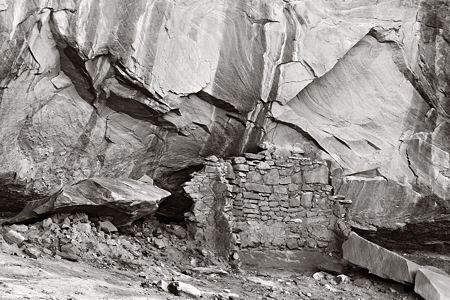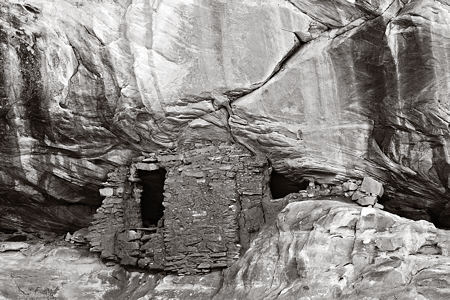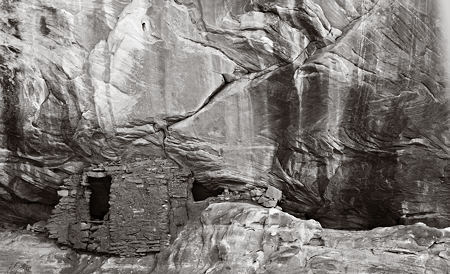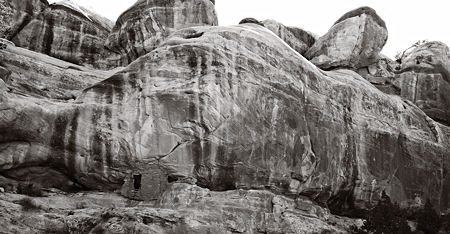I’ve just returned from a trip to the Colorado Plateau, my third since getting my camera. The canyon and mesa landscape is amazing, but most of my interest lately has centered around the ancient remains of human habitation, and their relationship to the landscape. I’ve focused on the small settlements and structures, and haven’t even been to larger sites like Mesa Verde in many years. My reasons: the small ruins are not on maps, there are no crowds, and the hiking and searching for them is a large part of the enjoyment.

The ruins evoke many thoughts and emotions. The image above, with parts of the structure shattered by falling rock from the cliff above, is one I find poignant. Despite the metaphorical implication, however, it is not true that the Anasazi world collapsed in some mysterious cataclysm; rather, the depopulation of the area some eight hundred years ago was more likely a response to drought and the conflict it led to.
Although people were more numerous in the area then than now, it is hard to resist viewing their existence as fragile. From our perspective, lacking knowledge of how they conceived their environment, they seem to have been at the mercy of natural phenomena. A cork at sea does not seem a fitting image for this arid setting, but somehow the rock surrounding a ruin near that first one suggested to me storm-driven waves. Below are photographs at three scales showing progressively more of the rock matrix that holds the dwelling in its grasp. Perhaps I’ve primed you too strongly by talking about it already, but does any one of them give you the impression I’m describing? Which version seems most powerful to you, or most compelling for whatever reason?



Like last year, my first glance over my new image trove had me cringing in disappointment. Nothing looked as great on the screen as it felt at the time I was photographing. If experience is a guide, however, I’ll feel better about it later. In fact, looking over last year’s images before leaving this time, I thought there were quite a few strong pictures that just needed some attentive effort. Somehow I never found the time… I hope I do before too long, and I’ll be showing more from this trip in future posts.

Steve,
The shots are magnificent. If find the first and last ones the most scary, crushing me by merely looking at them.
In the two middle ones, I find the habitation almost ‘cozy’. Perhaps, it due to the large door that looks like an open beak, singing.
Steve:
These little patches of construction, as human artifacts, are remarkably integrated into their natural environments. They seem to be ruins – and simultaneously not. I can imagine occupying one of these with a little patching here and there. But to do so in the spirit of the original occupants would require an utter transformation of my nature.
The rocks, billowing as you suggest in some geologic tempest, appear a blunt statement against which there was no human argument. Others would come to blast and hammer such rock, but for these it sufficed to find shelter among the crevasses. Now it is possible that just behind you there were the remains of an entire settlement and that this structure served some auxiliary purpose. But taken in isolation, it is poignant in its humility on one hand and in an odd power on the other to lay claim to those beetling formations.
Those are some great images. I’ve made these kinds of allusions before, but I get the feeling that your camera can see ghosts.
Birgit,
Somehow I missed noticing that an earlier comment never posted, but I agree that there is a certyain snugness in the way the ruins are often carefully fitted into the surrounding rock, including previously fallen slabs that are too huge to move. What’s most scary is sometimes the getting up or down to them.
Jay,
Yes, the integration with the environment is one of the most fascinating aspects. Of course, the construction materials are the local rock, mud, and sticks. One of the problems photographically is to help the structures stand out rather than completely blend in.
In this case, there were several other ruins remaining within a few hundred yards, and there were probably others that have left little or no trace.
As for ghosts, I do almost feel sometimes I can see people moving about, grinding corn at the metates, etc.
Thanks for posting these. I miss traveling in the rocky west and southwest — it’s such beautiful country.
In the the third pic (and slightly so in the fourth), there seems to be an enormous handprint in the cliff. I like the relative proportion of the dwelling to environs in #3, but the “hand” seems alternately humorous (Hi, Mom!) and sinister.
Melanie,
I had not noticed the hand before.
Pic #3 does have a sweet touch, hi, Mom the little says one with its mouth open.
Melanie,
I also saw the hand when I looked at the photograph, but not when I was taking it. Ironically, there are often real handprints of various types left by former inhabitants.
Loved reading this… Like always.
Fascinating – the Anasazi.
I love the Hopi (I think, Hopi) origin myth — it says that the people came up from under the earth, and the earth was soft, and wherever the people traveled, they left hand and foot prints in the soft earth.
This story probably arose from living in a land composed of volcanic ash and theorizing based on observation. The geology is astonishing and so evocative.
And the “seeing without seeing” aspect leads us back to the discussion in the next post, doesn’t it?